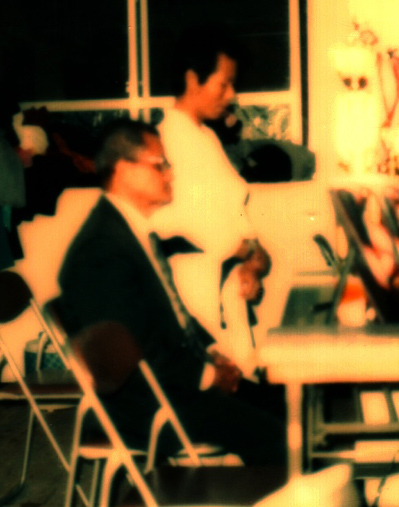Tatsuo's Son Ciso
Introduction • Part 1-The Man • Part 2-The Mentor • Part 3-The Devoted Son • Part 4-Yin & YangSHIMABUKU SHINSHO (CISO)
![]()
Shimabuku Shinsho (Ciso) March 3, 1942 - 2006 (True Date of Death Unknown)
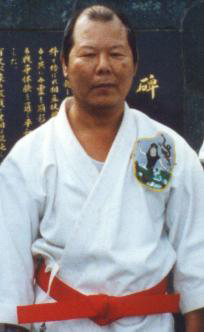 "When your father is alive, observe his will. When your father is dead observe his former actions. If, for three years you do not change from the ways of your father, you can be called a 'real son (hsiao filial).'"
"When your father is alive, observe his will. When your father is dead observe his former actions. If, for three years you do not change from the ways of your father, you can be called a 'real son (hsiao filial).'"
~ 1.11 Analects of Confucius, Charles Muller translation
Special Services had a contract with with Shimabuku Tatsuo having him teach karate to the Marines stationed at Camp S. D. Butler, Camp McTureous and Camp Courtney.
Camp S. D. Butler and Camp McTureous were both located near Kawasaki village so were sometimes called, Camp Kawasaki, where, Camp Courtney was located near Tengan village, so was also called Camp Tengan.
At the time, I was a Marine corporal E-3 stationed at Camp S. D. Butler on my first of several tours of duty on Okinawa.
Shimabuku Tatsuo Sensei had a contract to teac h Marines Isshin-ryu karate. Marine Corps Special Services as it was called at the time provide all recreation for Marines at the different Marine Corps Camps throughout Okinawa.
When I first started Isshin-ryu karate, Shimabuku Tatsuo Sensei was 50 years old. He was paid $5 US dollars for every student which also included Navy personnel assigned with the Marines. In the dojo assisting his father, was Shimabuku Shinsho, Tatsuo’s second son who was 16 years old, interperted for his father and helped Marines with their understanding of Isshin-ryu karatedo. Shinsho was called Ciso by most of the Marines simply because many could not correctly pronounce Shinsho.
 In 1969 I return to Okinawa and again see Ciso. He was a school teacher and taught shop in high school. The above photo was taken at the honbu dojo.
In 1969 I return to Okinawa and again see Ciso. He was a school teacher and taught shop in high school. The above photo was taken at the honbu dojo.
Again, I visited with Ciso on December 28, 1984. Ciso said, “My father called me Shinsho and at school they called me Shinshou and Americans called me Ciso.”
His father named him Shinsho and as is the Okinawan custom, took "Shin ![]() "from his given name "Shinkichi
"from his given name "Shinkichi ![]() " and named him "Shinsho
" and named him "Shinsho ![]() ". "Sho
". "Sho ![]() " in Shinsho means (peace) so Shinsho translates to "True or real
" in Shinsho means (peace) so Shinsho translates to "True or real
peace.” A fitting name for Shinsho from his father who was a man of peace.
Walter Van Gilson showed me a notebook where Ciso signed his name, “Shinshiyo.” His father, given name was Shinkichi. So as in Okinawan custom, he named his first and second sons from his given name. “Kichi” in Kichiro and “Shin” in Shinsho came from Shinikichi.
(photo) 1969 Agena Dojo, Gushik awa City, Okinawa. Ciso and Advincula.
(The names Kichiro and Shinsho are derived from Shinkichi)
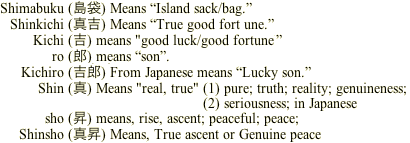
Ciso explains that the kanji for Shimabuku ![]() can be pronounced several ways. Shimabukuro or Shimabuku.
can be pronounced several ways. Shimabukuro or Shimabuku.
He explains, they use the shorter version, Shimabuku, instead of Shimabukuro. Ciso says both are correct.
According to Jim Breen on line Japanese Dictionary (Japanese Names (ENAMDICT), the kanji Tatsuo used for his family name Shimabuku ![]() .
.
The kanji translates to the following:

Shimabuku Shinsho ![]() who most marines called Ciso, was born March 3, 1942 in Chan village Okinawa. Shinso who I will call Ciso, was the second born son, of Shimabuku Tatsuo Sensei and Kichiro was the the first born. Ciso began training in Shorin-ryu karate at scho ol and at the same time learning and training from his father who was teaching at his father’s home dojo in Chan village. He was present at the meeting in the Chan village home and dojo. January 15, 1956, along with Kaneshi Eiko when his father announced he was going to now name his style, Isshin-ryu.
who most marines called Ciso, was born March 3, 1942 in Chan village Okinawa. Shinso who I will call Ciso, was the second born son, of Shimabuku Tatsuo Sensei and Kichiro was the the first born. Ciso began training in Shorin-ryu karate at scho ol and at the same time learning and training from his father who was teaching at his father’s home dojo in Chan village. He was present at the meeting in the Chan village home and dojo. January 15, 1956, along with Kaneshi Eiko when his father announced he was going to now name his style, Isshin-ryu.
His father taught Ciso not only karate, but also about the teachings of sumuchi (Fortuneteller). Learning directly from his father at the very beginning of Isshin-ryu and at a early age, who better knew more about his father’s teaching. Kichiro did not start karate until 1963 when he returned from college in Japan. I was there at the time on my second Okinawa tour of duty when he started karate. I have always said, Ciso was the most knowledgeable person in Isshin-ryu after his father. It was Ciso who besides his father, also taught Uezu Angi and then his older brother Kichiro.
After his father’s death on May 30, 1975, I would continue to visit Ciso and ask him about the finer points of Isshin-ryu and what his father taught. Ciso always enjoyed talking about his father, and his memory was always sharp. Whenever you talked about his father his eyes would light up.
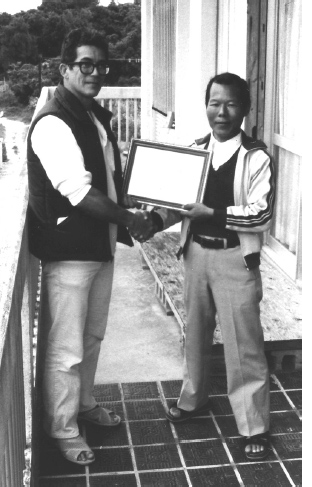 On several visits I would ask him questions to confirm what I knew to be facts about his father or Isshin-ryu. He always answered with a laugh or smile. We would then discuss my notes from other interviews and he would correct me if I did not get it right. Often he would elaborate or make a correction. Ciso enjoyed these visits and was happy to help me since I was always asking about what his father taught.
On several visits I would ask him questions to confirm what I knew to be facts about his father or Isshin-ryu. He always answered with a laugh or smile. We would then discuss my notes from other interviews and he would correct me if I did not get it right. Often he would elaborate or make a correction. Ciso enjoyed these visits and was happy to help me since I was always asking about what his father taught.
On the visit with Ciso in late December 1984, I had numerous questions for him and he gives me more valuable information about his father. Ciso’s mother, Uto, is living with him at his house. As Mrs. Shimabuku became older, she moved in with Ciso. Ciso then becomes his mother caretaker.
So I begin to ask Ciso about dates and times, when and how long his father studied with each sensei. Ciso stop’s me and tells me to come back the coming Friday which is December 28. He explains t hat his mother married his father in 1932, the same year his Tatsuo began training with Kyan Chotoku.
When I return, accompanied with Michie and one of my student’s, Cyrus Bess,
Ciso presents me with a framed Certificate of gratitude saying, “Only you can tell the story about my father. It is important, to teach my father’s gokui.”
(photo) December 28, 1984, Ciso presents a Certificate of Apreciation to Advincula at Ciso’s home in Kinaka, Gushikawa City, Okinawa.

Certificate Of Appreciation To Jim Advincula from Shimabuku Shinsho, 12-28-1984You have spent many years putting in tremendous effort both day and night for the progress of Isshinryu karatedo and the contributions you have made are enormous. So for your daily efforts I would like to present this certificate with much gratitude.
To Jim Advincula, December 28th, 1984, Isshinryu Karatedo Hanshi, Shimabuku Shinsho
Translation by Emi Tsutsumibayashi Chalker
![]() , Chatham Karate Academy, NJ.
, Chatham Karate Academy, NJ.
On my first Okinawa Cultural Martial Arts tour to Okinawa in 1994, I brought 14 people with me. One of the first things I did, was to call Ciso and ask if it was OK to bring others to visit him. He asked, “Do they have good heart?” I answered they were my students. He answered, “Then bring them. If they are your students, they must have good heart.” (photo) February 25, 2002 Advincula presents Ciso with a Isshin-ryu no Megami, a photo of Shimabuku Tatsuo, and notebooks on Isshin-ryu history. This was his trust in me. Ciso often told me others came to see him and ask questions but he never trusted them. In this case, because I said they were my students he would see them. This was Ciso, my dear friend. But Ciso was more then a friend, he was also one of my mentors. While he was four years my junior, in Isshin-ryu, he was his fathers second born son, but number-one, in following his fathers teachings. His father wanted Americans to learn about his Okinawan culture through karate and who knew more about what his father wanted then Ciso, the filial son. So what is a “Filial son”? First, let us see what is Filial piety. In Okinawa, filial piety is one of the most important Confucian virtues to be cultivated. Filial piety a love and respect for one's parents and ancestors. In this , Shinsho was his father’s son. In somewhat general terms, filial piety means to take care of one's parents; not be rebellious; show love, respect and support; display courtesy; ensure male heirs, uphold fraternity among brothers; wisely advise one's parents; conceal their mistakes; display sorrow for their sickness and death; and carry out sacrifices after their death. (photo) Ciso looking at my Handout on Isshin-ryu History 2002 (photo) 5.1.75, Grand opening Kinaka dojo, Gushikawa City, Okinawa. The devotion he had for his father can be seen in his eyes and fantastic smile. Ciso told me that it was the twenty-fourth year of the passing of his father and to please honor his father. He explained, in Okinawan custom, one paid respects to honor a deceased person on the twenty-fifth anniversary after death. I told him we would honor this Okinawan custom with an Isshin-ryu Enbukai to honor his father.
(photo) 5.1.75, Grand opening Kinaka dojo, Gushikawa City, Okinawa. Morning event: On October 21, 2000 the Isshin-Kai conducted a Enbukai, with karate and kobudo demonstrations at Camp Pendleton, California. What better honor then to have an Enbukai at a Marine Corp base for the 25th anniversary of Shimabuku Tatsuo's death. After all, Shimabuk Tatsuo Sensei had taught Marines throughout his life since 1955. At this Enbukai, approximately 56 karate-ka from 15 States and Canada attended this event. Representatives from each dojo demonstrated kata, kobudo and kumite. Afternoon October 21, 2000: Iha Kotaro President of Ryukonkai, came from Okinawa and did a karate and kobudo, seminar. He taught naihanchi kata with bunkai, and Ryukonkai, kobudo. This honor was for Shimabuku Tatsuo Sensei’s’ belief, “All bottles are good.” Yes, Ciso asked me to honor his father on the 25 TH anniversary after his death. We did, and it was all because of a filial son, who loved his father.PART 2 - The Mentor
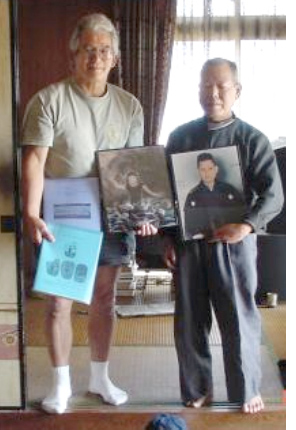 In February, 2002, I brought a small group of members of the Isshinkai on one of my several Okinawan Cultural Martial Arts Tours to Okinawa.
On February 25, 2002, we again went to visit Ciso. I presented Ciso with a Isshin-ryu Megami picture, a photo of his father, and several notebooks that I had made of history of Isshin-ryu compiled from prior visits and interviews with several of Shimabuku Tatsuo Sensei’s senior Okinawan students and also, from notes from prior visits with Ciso. It was Ciso who told me his father was a practitioner of Feng Shui and studied the constellations. Ciso confirmed that his father took his name “Tatsuo
In February, 2002, I brought a small group of members of the Isshinkai on one of my several Okinawan Cultural Martial Arts Tours to Okinawa.
On February 25, 2002, we again went to visit Ciso. I presented Ciso with a Isshin-ryu Megami picture, a photo of his father, and several notebooks that I had made of history of Isshin-ryu compiled from prior visits and interviews with several of Shimabuku Tatsuo Sensei’s senior Okinawan students and also, from notes from prior visits with Ciso. It was Ciso who told me his father was a practitioner of Feng Shui and studied the constellations. Ciso confirmed that his father took his name “Tatsuo ![]() ” from the Azure dragon of the East or (Seiryuu
” from the Azure dragon of the East or (Seiryuu ![]() ). The three stars (* * *) Isshin-ryu Goddess were from the heart of the Dragon constellation and is the “shin
). The three stars (* * *) Isshin-ryu Goddess were from the heart of the Dragon constellation and is the “shin ![]() or “heart” of the Azure dragon. Only Ciso who was taught the innermost secrets of a sumuchi and would know these things. Ciso often said, “My father wanted Americans to know more about “gokui (essential points) of Isshin-ryu karate but they only had a year to learn on Okinawa. So he only taught the basics or the physical applications.” Ciso always reminded me, “Please teach them gokui.”
or “heart” of the Azure dragon. Only Ciso who was taught the innermost secrets of a sumuchi and would know these things. Ciso often said, “My father wanted Americans to know more about “gokui (essential points) of Isshin-ryu karate but they only had a year to learn on Okinawa. So he only taught the basics or the physical applications.” Ciso always reminded me, “Please teach them gokui.”
Now the true character of a person is found in a persons heart. Ciso always gave of himself.
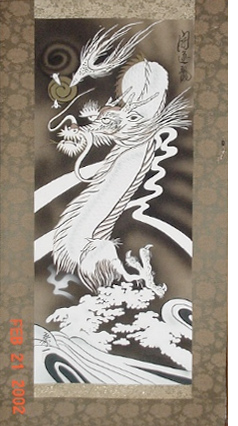 On my first Okinawa Cultural Martial Arts tour to Okinawa in 1994, I brought 14 people with me. One of the first things I did, was to call Ciso and ask if it was OK to bring others to visit him. He asked, “Do they have good heart?” I answered they were my students. He answered, “Then bring them. If they are your students, they must have good heart.”
On my first Okinawa Cultural Martial Arts tour to Okinawa in 1994, I brought 14 people with me. One of the first things I did, was to call Ciso and ask if it was OK to bring others to visit him. He asked, “Do they have good heart?” I answered they were my students. He answered, “Then bring them. If they are your students, they must have good heart.”
(photo) Hanging in Ciso's house was a dragon (Tatsu ![]() ) , representing his father, Tatsuo
) , representing his father, Tatsuo ![]() , The Dragon-man of Isshin-ryu, Karatedo and Kobudo.
, The Dragon-man of Isshin-ryu, Karatedo and Kobudo.
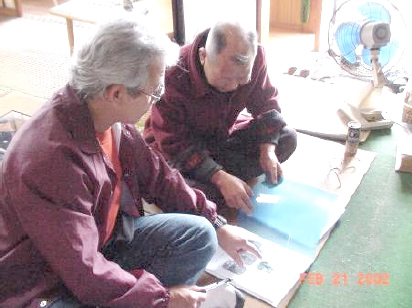
PART 3 - The Devoted Son
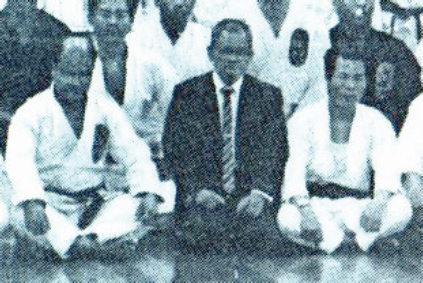 The story behind the above picture. This was the grand opening of a new Isshin-ryu Headquarters dojo on 05-01-75, in Kinaka, Gushikawa City, Okinawa. Front row center in a suit is Shimabuku Tatsuo Sensei. To his right with his head slumped, is Tatsuo's first born son, Kichiro. To his left is his second born son Shinsho. Notice the body language. While this is the grand opening, and Kichiro is now in charge, his head is slumped forward. Shimabuku Tatsuo Sensei seems to lean away from Kichiro and sits close to Ciso where their arms are touching.
The story behind the above picture. This was the grand opening of a new Isshin-ryu Headquarters dojo on 05-01-75, in Kinaka, Gushikawa City, Okinawa. Front row center in a suit is Shimabuku Tatsuo Sensei. To his right with his head slumped, is Tatsuo's first born son, Kichiro. To his left is his second born son Shinsho. Notice the body language. While this is the grand opening, and Kichiro is now in charge, his head is slumped forward. Shimabuku Tatsuo Sensei seems to lean away from Kichiro and sits close to Ciso where their arms are touching.
Earlier I visited Sensei’s house in Agena and he told me about the new dojo about to be opening up. He told me about the grand opening that all were invited to see demonstrations and matches. I asked if he was going, and Sensei said no. His son was now the head of Isshin-ryu. I told Sensei that as far as I was concerned he was the head and always would be the head of Isshin-ryu. I also said he should attend the event. Sensei did attend the event and Kichiro did not know he was comig to the event. The vary reason, Kichiro’s head is slumped forward is because most of the senior Okinawans still recognized Shimabuku Tatsuo Sensei as the head of Isshin-ryu. This is the story about the above picture. Its all about body language. As we can see, Sensei was vary close to Ciso, no pun intended.
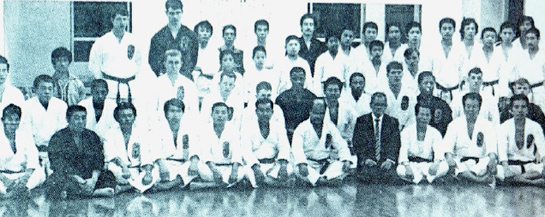
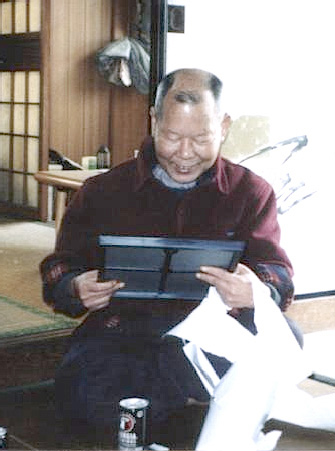
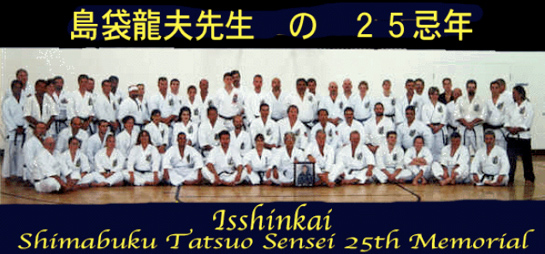

Here is a story of a filial son looking to the future. Ciso told his father to have a photo made to be used in all Isshin-ryu dojo after he passes away. His father complied and today, because of Ciso, we have the following picture of Shimabuku Tatsuo Sensei to display in our dojo.

Shimabuku Tatsuo Sensei is wearing a formal kimono with the Royal crest of the old Ryukyu Kingdom. Today, the Royal crest of the Ryukyu Kingdom represents Okinawa.
Hidari-Mitsu-domoe in Japanese means:
Hidari ![]() = “Left,” Mitsu = “the three
= “Left,” Mitsu = “the three ![]() ” domoe changes to tomoe
” domoe changes to tomoe ![]() = the three comma-shaped figures in a circle is a eddy whirling the same as a whirlpool of the water. When said, (Hidari (left) Mitsu (3), tomoe (comma-shaped figures) becomes, Hidari Mitsu Tome or (dome).
= the three comma-shaped figures in a circle is a eddy whirling the same as a whirlpool of the water. When said, (Hidari (left) Mitsu (3), tomoe (comma-shaped figures) becomes, Hidari Mitsu Tome or (dome).
So again we have Ciso looking out for his father, looking to the inevitable day when his father will no longer be with us in body, but in spirit. This is Ciso legacy to all the future generations of Isshin-ryu karateka. What a gift Ciso gave to us to know, each time we see Shimabuku Tatsuo Sensei’s portrait wearing his formal ceremonial traditional kimono with the Old Ryukyan Royal family crest representing Okinawan we are reminded of the following.
The old Ryukyan Royal crest represents the past when Okinawa was a tiny kingdom. It represents the present, an Okinawan wearing a Japanese formal kimono with an Okinawan crest blending the two cultures. The portrait of our founder represents future which is his spirit which is the heart and soul of Isshin-ryu Karate and Kobudo.
Ciso was always in the background yet always there. While other always took the undeserved credit Ciso knew his father cared and trusted him. Wemust never forget that his father was a sumuchi (スムチ) or shimuchi (シムチ) fortuneteller also called sanzinzo. “Sumuchi” in the Okinawan language means “book” and “sanjinso (サンジンソー)” literally means “Three phases of life(三世 相)”meaning, past, present and future. Now Shimabuku Tatsuo Sensei named his first born son Kichiro which means, “Lucky son” and he named his second born son Shinsho (真昇). Shinsho is created by two Chinese characters, “shin (真)” which means “real, reality, actual, true, truth, genuine, right,” and “sho (昇)” which means “rise, ascent, peaceful, peace, to climb, to rise, go up. So Shinsho, means any of the following, “ Real peace, Actual peace, Genuine peace, True peace, Pure peace, Right peace, Truth rises, True ascent, Truth rises, Truth climbs, True ascension, Right ascension.”
In researching the “sho” in Shinsho’s name, in a Japanese Character Dictionary1, “sho” is also “noboru or nobori.” Now “sho (昇) ”, “nobori or noboru (上)”, and “jo (登),” all have the same meaning.
March 30, 1986, Gushikawa, Okinawa. Photo above taken at Ciso house Kinaka, Gushikawa. 1961/62 Marine Corps Triad Newspaper article. Agena dojo 1960. Sitting is Shimabuku Tatsuo Sensei. While most Americans who studied on Okinawa when Ciso was assisting his father may think they are senior, they would be wrong! In age yes, in knowledge no. While they may have made inflated high ranks, Ciso was wearing a white belt and yet was following his fathers teaching and trying to explain his teachings to the less knowledgeable American GI’s who first started Isshin-ryu karate on Okinawa. Harold Long went to Okinawa wit h Richard Keith and started Isshin-ryu karate at the Agena dojo from 1957 to 1958, praised Ciso saying he translated for his father an helped him when he trained at Agena dojo.(3)
Richard Keith who studied with Shimabuku Tatsuo at the Agena dojo in 1957 to 1958 remembers Shinsho. He remembers how Shinsho, as a teenager did much of the training and teaching marines and interpreting for his father when Keith first arrived and trained in the Agena dojo, In early 1957.(4) Jake Eckenrode who studied at the Agena dojo 1959 to 1960 said this about Ciso. “Ciso is an outstanding young boy, and friend, and a great Karate-Ka. He taught and polished me up to receiving my Shodan. He taught me all I could ever want to know and he teaches the marine black belts although he only holds a white belt - you figure it out! Guess it does not matter to the Okinawans as they are pure and don't boast.”(5) Clarence Ewing who studied at the Agena dojo 1959 to 1960 when asked about Ciso said, “Ciso Shimabuku- He always helped me with katas; he was the greatest! My pet name for him was “Sukoshi Tom Lewis who trained at the Agena dojo 1959 to 1960 “I was very saddened when I heard the passing of Ciso. I liked him a lot and thought he was very much like his dad. What I remember most about him, aside from his superb technique, he had a good sense of humor and his goal was to become a school teacher. I think a lot of us wished he had been more involved in his fathers karate, he had much to offer. He will be missed. Tom. p.s. I saw him dump Steve Armstrong on the floor when they were just horsing around.”(7) Shigema Genyu, Kaneshiro Kenji and Kaneshi Eiko, Tatsuo’s right-hand-man on December 24, 1984, in an interview with the three, they all said Ciso was a good man, Uezu Angi was OK, and none of them thought much of Kichiro.(8)PART 4 - Ying & Yang
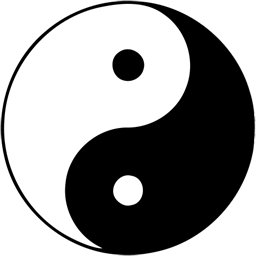
Jim Breen WWW Japanese Dictionary2 translates all three Chinese characters
(昇, 上 登), “sho (昇)”, “nobori or noboru (上)”, and “jo (登),” all have the same
translation: 昇る 【のぼる】; 上る; 登る; (v5r, vi) (1) to ascend; to go up; to
climb; (2) to ascend (as a natural process, e.g. the sun); to rise; (3) to go to
(the capital); (4) to be promoted; (5) to add up to; (6) to advance (in price);
(7) to swim up (a river); to sail up; (8) to come up (on the agenda);
As I said above, The Modern Reader’s, Japanese-English Character
Dictionary, 2nd Edition, by Andrew N. Nelson refers the Chinese character “sho
(昇)”, to “see under 上 798.0.” The literal translation is, “(上) Jo top; best; Sho
(上) upper part; top; summit; far better; higher; (in) authority; etc.
Well the point is, Shimabuku Tatsuo Sensei, as a sumuchi (Fortuneteller), did foresee the future by the names he gave his two sons. Yes, Kichiro is the “Lucky son” having been born first and inheriting all the luxuries and titles as a first born son. Ciso being the second son always was ignored in the in the Kichiro and Uezu (Angi) Isshin-ryu hierarchy. Ciso always took a back seat to his older brother Kichiro and his brother-in-law Angi, even though he taught both of them. I once saw a video taken by Greg Gudson where Uezu Angi claimed to have taught Ciso. But then at one time, Angi also claimed to have taught me and Tokumura Kensho.
1) The Modern Reader’s, Japanese-English Character Dictionary, 2nd Edition, by Andrew N.
Nelson
2) Jim Breen WWW Japanese Dictionary (see Google)
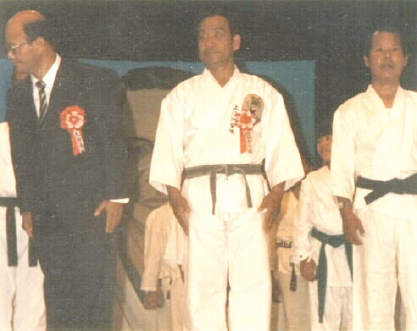
Left to right, Shimabuku Kichiro, Uezu Angi and Shimabuku Shinsho (Ciso). A Enbu Taikai ![]() was held in Okinawa to commemorate the 40 TH anniversary of Tatsuo teaching karate. According to Ciso, his father opened his first dojo in Honbu village, Gushikawa City, in 1946.
was held in Okinawa to commemorate the 40 TH anniversary of Tatsuo teaching karate. According to Ciso, his father opened his first dojo in Honbu village, Gushikawa City, in 1946.
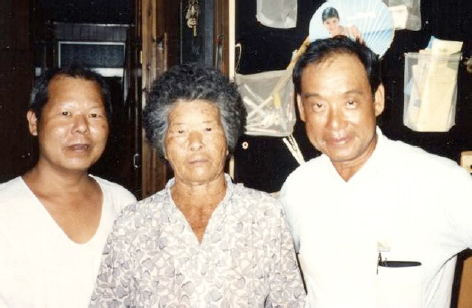
Left to right: Ciso, Uto his mother and Uezu Angi who is visiting Ciso’s house.
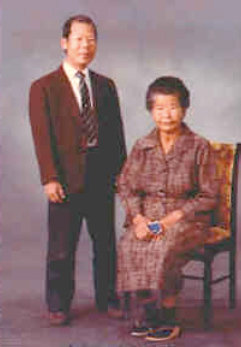 For years he took care of his mother until she needed extra special care as she aged. Ciso told me he could no longer assist his mother needs when she had to go to use the bathing and toilet facilities. Ciso explained his older sister Yukiko who was married to Uezu Angi would have to help her. In Okinawa tradition it is a daughter who takes care of a mother when she gets older and needs more care. Simply because a daughter can assist her mother when it comes to hygiene practices. So around 1998 his mother moved in with her daughter Yukiko.
For years he took care of his mother until she needed extra special care as she aged. Ciso told me he could no longer assist his mother needs when she had to go to use the bathing and toilet facilities. Ciso explained his older sister Yukiko who was married to Uezu Angi would have to help her. In Okinawa tradition it is a daughter who takes care of a mother when she gets older and needs more care. Simply because a daughter can assist her mother when it comes to hygiene practices. So around 1998 his mother moved in with her daughter Yukiko.
Mrs. Shimabuku always served tea or other drinks whenever we visited her and Ciso. She knew Michie and her mother and on some occasions Michie’s mother would come with us and vist her friend while we were visiting Ciso. On one of our visits, she told Michie she remember we came and visited them in early May, 1975, a month just before her husband, Tatsuo, died.
(photo) Shinsho the filial son with his mother Uto.
Photo, courtesy of Ciso.
The duty of a filial son is taking care of one’s parents. While he was forced to stand back when it came to karate social events, he stood above all when it came time to honor his parents. That is what a filial son is suppose to do.
PART 5 - The Humble Son
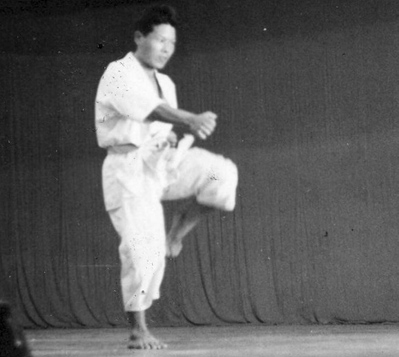 The true sign of a person is found in what others say about you. In the so called Isshin-ryu world, Americans and Westerners prefer to look to the future instead of following the past. While in Asian culture it is important to follow the past which will show you the way to the future. Americans and Westerners like to show and brag about their accomplishments, in sports, showing trophies, announcing their titles and along with their rank.
The true sign of a person is found in what others say about you. In the so called Isshin-ryu world, Americans and Westerners prefer to look to the future instead of following the past. While in Asian culture it is important to follow the past which will show you the way to the future. Americans and Westerners like to show and brag about their accomplishments, in sports, showing trophies, announcing their titles and along with their rank.
(photo) Ciso demonstration seisan kata 1960.
Photo courtesy of Jake Eckenrode.
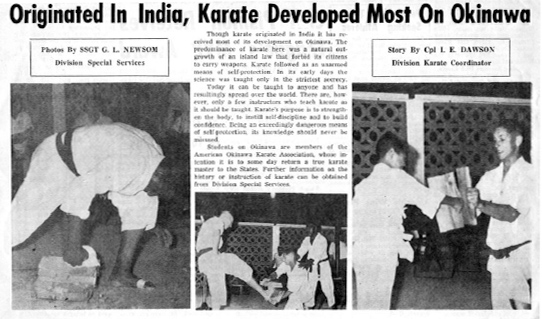
In photograph on the right, is Ciso wearing a white belt is punching through boards held by Bill Blond./span>

To his left knelling, is Ciso. Standing behind Shimabuku Tatsuo Sensei, is Bill Blond in the striped kendo gi and Steve Armstrong to Bill Blond’s left
Others who have praised Ciso
![]() Sensei” meaning little sensei.”(6)
Sensei” meaning little sensei.”(6)
4) Telcon Interview with Richard Keith and Arcenio Advincula 10-13-97
5) & 6) From Don Bohan web page Click Here
7) Posted October 7, 2006, on the Isshinkai Yahoo, group, Message 23449: Click Here
8) In an interview 12-24-1984 at Taba, Gushikawa City, Okinawa
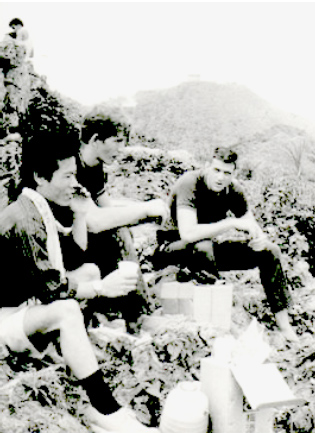
(photo) left to Right: ciso, WalterVan Gilson and bob Bremer, hiking on Okinawa.
Now to the purpose of this article, Shimabuku Shinso, the filial son, as I have stated, was not only my friend, he was a mentor to me. A mentor will help another person in order to help that other person to do a job more effectively. The mentor as a rule is someone who had "been there, done that" befo re. A mentor might use a variety of approaches, eg, coaching, training, discussion, counseling, etc., and as we know, Ciso was before all of us. He was teaching marines the day I got to the dojo. So he as Clarence Ewing said, was Sukoshi Sensei (Little Sensei) but to me, he was just like his father.
Just as Jake Eckenrode said about Ciso, “Ciso only holds a white belt - you figure it out! Guess it does not matter to the Okinawans as they are pure and don't boast.”
No! Ciso NEVER boasted. It was all about his father and his fathers teachings. “Plea se honor my father” Ciso said to me. In the real world, he proved he was the devoted and filial son by his actions of taking care of his mother in his home until she needed special care.
Today too many make up or embellish their accomplishments to seek and obtain mere titles, ranks, or honors not earned. To them, loyalty is only a word set aside so they can strut about like peacocks with others of their kind trying to out do each other. It is easy to find this type because their ego’s shine out by reading their embellish resumes and by them wearing garnished uniforms with elaborated belts. They incorrectly call themselves Sensei or Shihan and use the word (I) in every sentence of the exaggerated or made up accomplishments.
To Shimabuku Shinsho, better known as Ciso to the Marines who studied at the honbu dojo, in Agena, Gushikawa City, Okinawa. The one who was there at the beginning assisting his father explaining the gokui of Isshin-ryu. The one who always told me, “Please honor my father; Please burn incense at my fathers tomb; Please teach others my father’s teachings; Please teach them Isshin=ryu gokui.”
The master (Confucius) said: "A young man should serve his parents at home and be respectful to elders outside his home. He should be earnest and truthful, loving all, but become intimate with jen. After doing this, if he has energy to spare, he can study literature and the arts." ~ 1.6 Analects of Confucius Charles Muller translation.
Comment from Charles Muller [In terms of the development of the character of the human being, the most fundamental practice is that of "filial piety," the English translation of the Chinese hsiao, which means to love, respect and take care of one's parents. Confucius believed that if people cultivated this innate tendency well, all other natural forms of human goodness would be positively affected by it.]
Yes Ciso, I will teach others about your fathers innermost teachings. One thing for sure, you are your father’s and mothers son, The Filial Son. Good marines understand that, we call it, Semper Fidelis (Always Faithful).
For my 50 TH anniversary in Isshin-ryu Karatedo and Kobudo, I will be posting the interviews of Shimabuku Shinsho. If it was not for him, my further education in Isshin-ryu would have never matured. He helped me understand, the true teaching of his father’s gokui. Ciso often said, “Please teach them gokui.”
05-01-75, Ciso with his father at the Grand opening Kinaka dojo, Gushikawa City, Okinawa. Thirty days later, the Dragon of Isshin-ryu passed away. Today their spirits are together, the father with his filial son.
